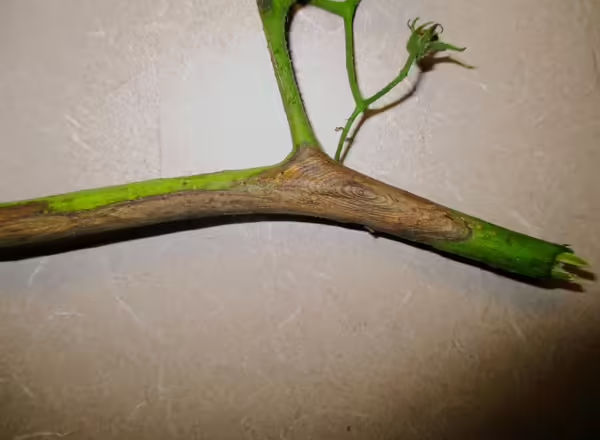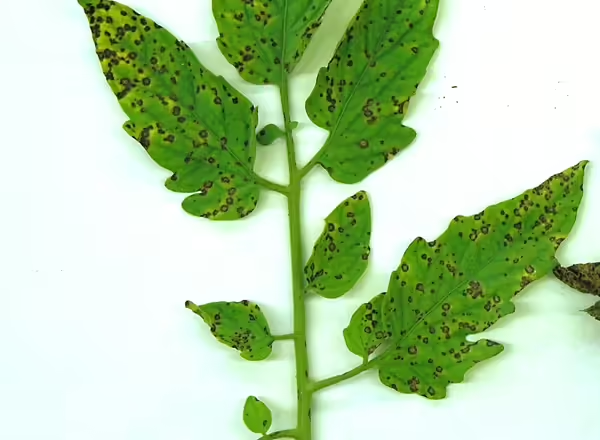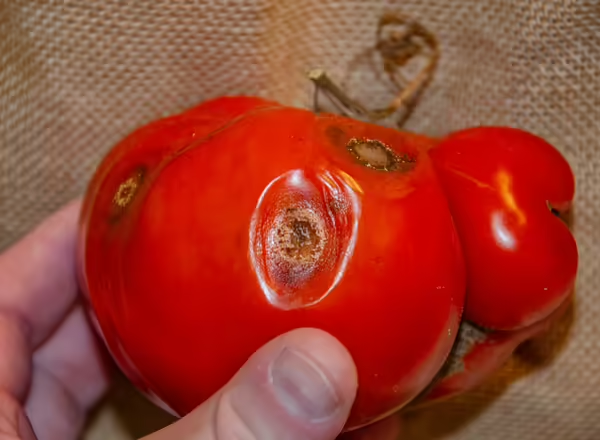
Tomatoes are one of the most commonly grown vegetables in home gardens. While tomatoes are relatively easy to grow, there are a few diseases you should keep your eye out for. Three of the most common diseases people encounter are early blight, Septoria leaf spot, and anthracnose. All of these diseases are caused by fungi, and consistently wet conditions are needed for these diseases to develop.
Early blight (Alternaria solani) primarily infects the foliage of plants, but it can also infect the stem and fruit. It appears as irregularly shaped brown spots that have concentric rings (resembling a bull's-eye or target), commonly on older leaves. The spots are often surrounded by yellow tissue. The spot can grow to be ¼ to ½ inch in diameter and will often grow together (coalesce), forming large brown areas. Eventually, leaves will drop off plants.
Septoria leaf spot (Septoria lycopersici) is also primarily a leaf infection, but it will also infect the stems (rarely infects fruit). It forms small (1/16 to 1/8 of an inch) circular spots on leaves. These spots have a tan or light-colored center with dark purple or brown margins. Spots will grow to be around ¼ of an inch in diameter. Like early blight, the individual leaf spots will often coalesce, forming large areas of diseased tissue. Heavily infected leaves will turn yellow and fall off the plant. Unlike early blight, it does not form concentric rings. But, if you look closely (you may need to use a magnifying glass), you can often see small black pimple-like fruiting bodies in the center of the leaf spots.
Anthracnose (Colletotrichum spp.) is primarily a fruit disease. Circular sunken lesions develop on fruit. Over time, these spots will enlarge and darken. Often, pink to orange masses of spores form in concentric rings on the surface (especially when it’s humid). Anthracnose may occasionally be found on leaves and stems, where it will cause irregularly shaped brown spots with dark brown edges.



Managing tomato diseases
There are several things you can do to manage these diseases.
- Remove and destroy any diseased foliage and fruit to help prevent disease from spreading further. When removing it, don’t just throw it on the ground; get it out of the garden!
- Make sure plants are dry before working with them; if leaves are wet, you may end up spreading the disease.
- When watering plants, avoid watering late in the day and try not to get the foliage wet. The longer the leaves remain wet, the greater the chance that disease will develop.
- Early blight and anthracnose can survive in the soil, on seeds, or in infected plant debris. While Septoria can survive for up to three years on infected plant debris, as well as weedy hosts, it does not survive in the soil on its own. Because these diseases can survive on plant debris, it is important to remove any diseased plant tissues from your garden.
- Using mulch around plants can help create a barrier between the soil and the plants, helping prevent spores that may be in the soil from getting onto plants.
- Controlling susceptible weeds, like nightshade, and volunteer tomato plants that can act as a source of infection, are also important parts of keeping your garden clean.
- Fungicides can also be applied to plants. This will not get rid of the disease on infected leaves, but will protect healthy leaves from infection. When using pesticides, make sure to read and follow all label directions. Contact your local extension office to get a list of recommended chemicals.
Preventing tomato diseases in the future
There are also several different things you can do to manage these diseases in your garden for next year.
- Make sure you are practicing crop rotation. Ideally, you wouldn’t grow any solanaceous (tomato family; includes peppers, eggplants, and potatoes) plants in the same area (this is often easier said than done in backyard gardens).
- If you are growing tomatoes from seed, look for disease-free seed. If you save seeds, make sure you are saving seeds from healthy fruit.
- If you are purchasing transplants, inspect plants for any leaf spots before purchasing.
- Regardless of whether you are growing from seed or transplants, look for disease-resistant varieties.
- Providing adequate spacing can help reduce disease in tomatoes. This will allow airflow between plants, and it will allow them to dry out faster. It is also a good idea to stake or cage your tomatoes. This helps speed up the drying of plants and keeps them off of the ground.
Good Growing Tip of the Week: Contrary to popular belief, blossom end rot is not caused by a pathogen or insects; it is actually a physiological disorder. The cause of blossom end rot is poorly understood. It has commonly been believed that it is caused by low levels of calcium in developing fruit, or due to stress on the plant (read more about the causes of blossom end rot).
Want to get notified when new Good Growing posts are available? SIGN ME UP!
Give us feedback! How helpful was this information (click one): Very helpful | Somewhat helpful | Not very helpful
MEET THE AUTHOR
Ken Johnson is a Horticulture Educator with University of Illinois Extension, serving Calhoun, Cass, Greene, Morgan, and Scott counties since 2013. Ken provides horticulture programming with an emphasis on fruit and vegetable production, pest management, and beneficial insects. Through his programming, he aims to increase backyard food production and foster a greater appreciation of insects.